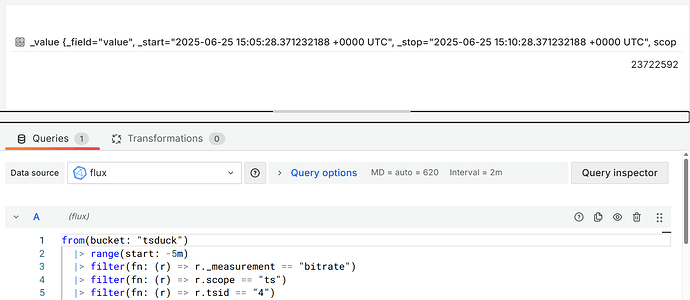- Grafana 12.0.2, installed as container from image grafana/grafana-oss:latest on macOS
- InfluxDB 2.7, installed as container from image influxdb:2.7.
Hi,
Being a total n00b with Grafana, please be forgiven about the level of this question. I try to integrate Grafana visualization with the open source project TSDuck and try to educate myself about Grafana.
I start with simple things, before getting more ambitious. I did a Grafana + InfluxDB setup using a dual-container and docker-compose, as documented online (exact procedure here if needed).
I get error “Data is missing a time field” trying to create a Flux query. The data do have a timestamp field. The problem is probably obvious but I couldn’t find an explanation.
Monitoring data are sent by the application to InfluxDB in this format:
bitrate,scope=ts,tsid=4 value=23722592 1750858324051
bitrate,scope=pid,pid=8191 value=0 1750858324051
I select “Create dashboard”, “Add visualization”, select “influxdb (default)” as data source, enter a Flux query such as:
from(bucket: "demo-bucket")
|> range(start: -5m)
|> filter(fn: (r) => r._measurement == "bitrate")
|> filter(fn: (r) => r.scope == "ts")
|> filter(fn: (r) => r.tsid == "4")
|> mean()
After hitting “Refresh”, I get “Data is missing a time field”.
Here is the content of the InfluxDB database (shrinked view with _start and _stop time removed);
$ influx query 'from(bucket:"demo-bucket") |> range(start:-20s)'
Result: _result
Table: keys: [_start, _stop, _field, _measurement, pid, scope]
_field:string _measurement:string pid:string scope:string _time:time _value:float
------------- ------------------- ------------ ------------ ---------- ------------
value bitrate 8191 pid ...000000Z 0
value bitrate 8191 pid ...000000Z 0
value bitrate 8191 pid ...000000Z 0
value bitrate 8191 pid ...000000Z 0
value bitrate 8191 pid ...000000Z 0
value bitrate 8191 pid ...000000Z 0
value bitrate 8191 pid ...000000Z 0
value bitrate 8191 pid ...000000Z 0
Table: keys: [_start, _stop, _field, _measurement, scope, tsid]
_field:string _measurement:string scope:string tsid:string _time:time _value:float
------------- ------------------- ------------ ------------ ---------- ------------
value bitrate ts 4 ...000000Z 23549632
value bitrate ts 4 ...000000Z 23758430
value bitrate ts 4 ...000000Z 23736128
value bitrate ts 4 ...000000Z 23735855
value bitrate ts 4 ...000000Z 23759888
value bitrate ts 4 ...000000Z 23720271
value bitrate ts 4 ...000000Z 23752360
value bitrate ts 4 ...000000Z 23725600
Thanks for your help.
